SARchaeology—Detecting Palaeochannels Based on High Resolution Radar Data and Their Impact of Changes in the Settlement Pattern in Cilicia (Turkey)
Abstract
:1. Introduction
2. Materials and Methods
2.1. Settlement Database
2.2. CORONA Satellite Imagery
2.3. TanDEM-X: TerraSAR-X Add-on for Digital Elevation Measurement
3. Results
3.1. Palaeochannels and Relict Canals
3.2. Distribution of Archaeological Sites in the Area
4. Discussion
4.1. Dating of Palaeochannels and the Relict Canals
4.2. Irrigation System
4.3. The Advantage of High Resolution DEM Data for Archaeology
5. Conclusions
Acknowledgments
Author Contributions
Conflicts of Interest
References
- Gürbüz, K. An example of river course changes on a delta plain: Seyhan Delta (Cukurova plain, southern Turkey). Geol. J. 1999, 34, 211–222. [Google Scholar] [CrossRef]
- Erol, O. Ceyhan Deltasinin Jeomorfolojik Evrimi: Geomorphological Evolution of the Ceyhan River Delta: Eastern Mediterranean Coast of Turkey. Aegean Geogr. J. 2003, 12, 58–81. [Google Scholar]
- Mahmoud, Y.; Masson, F.; Meghraoui, M.; Cakir, Z.; Alchalbi, A.; Yavasoglu, H.; Yönlü, O.; Daoud, M.; Ergintav, S.; Inan, S. Kinematic study at the junction of the East Anatolian fault and the Dead Sea fault from GPS measurements. J. Geodyn. 2013, 67, 30–39. [Google Scholar] [CrossRef]
- Öner, E.; Hocaoğlu, B.; Uncu, L. Palaeogeographical Surveys around the Mound of Gözlükule (Tarsus). In Field Seasons 2001–2003 of the Tarsus-Gözlükule Interdisciplinary Research Project; Özyar, A., Ed.; Ege Yayınları: İstanbul, Turkey, 2005; pp. 69–82. [Google Scholar]
- Adams, R.M. Heartland of Cities. Surveys of Ancient Settlement and Land Use on the Central Floodplain of the Euphrates; The University of Chicago Press: Chicago, IL, USA, 1981. [Google Scholar]
- Newhard, J.M.L.; Levine, N.; Rutherford, A. Least-Cost Pathway Analysis and Inter-Regional Interaction in the Göksu Valley, Turkey. Anatol. Stud. 2008, 58, 87–102. [Google Scholar] [CrossRef]
- Ehringhaus, H.; Starke, F. Götter, Herrscher, Inschriften. Die Felsreliefs der Hethitischen Grossreichszeit in der Türkei; Philipp von Zabern: Mainz, Germany, 2005. [Google Scholar]
- Schiettecatte, J.P. Geology of the Misis Mountains. In Geology and History of Turkey; Campbell, A.S., Ed.; Petroleum Exploration Society of Lybia: Tripoli, Libya, 1971; pp. 305–315. [Google Scholar]
- Jarvis, A.; Reuter, H.I.; Nelson, A.; Guevara, E. CGIAR-CSI SRTM 90 m Database. Hole-filled SRTM for the Globe Version 4. 2008. Available online: http://srtm.csi.cgiar.org (accessed on 18 October 2017).
- Forlanini, M. How to infer ancient roads and itineraries from heterogeneous Hittite texts: The case of the Cilician (Kizzuwatnean) road system. Riv. Stor. Ambient. Cult. Vicino Oriente Antico 2013, 10, 1–34. [Google Scholar]
- Aksu, A.E.; Calon, T.J.; Hall, C.J.; Mansfield, S.; Yaşar, D. The Cilicia–Adana basin complex, Eastern Mediterranean: Neogene evolution of an active fore-arc basin in an obliquely convergent margin. Mar. Geol. 2005, 221, 121–159. [Google Scholar] [CrossRef]
- Burton-Ferguson, R.; Aksu, A.E.; Hall, C.J. Seismic stratigraphy and structural evolution of the Adana Basin, eastern Mediterranean. Mar. Geol. 2005, 221, 189–222. [Google Scholar] [CrossRef]
- Isola, I.; Bini, M.; Ribolini, A.; Zanchetta, G.; D’Agata, A.L. Geomorphology of the Ceyhan River lower plain (Adana Region, Turkey). J. Maps 2017, 13, 133–141. [Google Scholar] [CrossRef]
- Aksu, A.E.; Ulug, A.; Piper, D.; Konuk, Y.T.; Turgut, S. Quaternary sedimentary history of Adana, Cilicia and Iskenderun Basins: Northeast Mediterranean Sea. Mar. Geol. 1992, 104, 55–71. [Google Scholar] [CrossRef]
- Akbulut, N.; Bayarı, S.; Akbulut, A.; Şahin, Y. Rivers of Turkey. In Rivers of Europe; Tockner, K., Ed.; Elsevier: Amsterdam, The Netherlands, 2009; pp. 643–672. [Google Scholar]
- Bal, Y.; Çetin, H.; Demirkol, C. An update on the coastline changes and evolution of the Seyhan and Ceyhan Deltas in the Northeast Mediterranean, Turkey. In Proceedings of the International Symposium on Geology and Environment, GEONEV ‘97, Istanbul, Turkey, 1–5 September 1997; p. 64. [Google Scholar]
- Çetin, H.; Bal, Y.; Demirkol, C. Engineering and Environmental Effects of Coastline Changes in Turkey, Northeastern Mediterranean. Environ. Eng. Geosci. 1999, 5, 1–16. [Google Scholar]
- Spezzaferri, S.; Basso, D.; Koral, H. Holocene palaeoceanographic evolution of the Iskenderun Bay, South-Eastern Turkey, as a response to river mouth diversions and human impact. Mediterr. Mar. Sci. 2000, 1, 19–43. [Google Scholar] [CrossRef]
- Walsh-Kennedy, S.; Aksu, A.E.; Hall, C.J.; Hiscott, R.N.; Yaltırakb, C.; Çifçic, G. Source to sink: The development of the latest Messinian to Pliocene-Quaternary Cilicia and Adana Basins and their linkages with the onland Mut basin, eastern Mediterranean. Tectonophysics 2014, 622, 1–21. [Google Scholar] [CrossRef]
- Bal, Y.; Kelling, G.; Kapur, S.; Akça, E.; Çetin, H.; Erol, O. An improved method for determination of Holocene coastline changes aroun two ancient settlements in southern Anatolia: A geoarchaeological approach to historical land degradation studies. Land Degrad. Dev. 2003, 14, 363–376. [Google Scholar] [CrossRef]
- Evans, G. The recent sedimentation of Turkey and the adjacent Mediterranean and Black Seas: A review. In Geology and History of Turkey; Campbell, A.S., Ed.; Petroleum Exploration Society of Lybia: Tripoli, Turkey, 1971; pp. 385–406. [Google Scholar]
- Evans, G. Recent coastal sedimentation: A review. In Marine Archaeology, Proceedings of the 23rd Symposium of the Colston Research Society, Bristol, UK, 4–8 April 1971; Blackman, D.J., Ed.; Butterworths: London, UK, 1973; pp. 89–112. [Google Scholar]
- Kuleli, T. Quantitative analysis of shoreline changes at the Mediterranean Coast in Turkey. Environ. Monit. Assess. 2010, 167, 387–397. [Google Scholar] [CrossRef] [PubMed]
- Kelletat, D. A Holocene Sea Level Curve for the Eastern Mediterranean from Multiple Indicators. Z. Geomorphol. 2005, 137, 1–9. [Google Scholar]
- Steadman, S.R. Prehistoric sites on the cilician coastal plain: Chalcolithic and early bronze age pottery from the 1991 Bilkent University Survey. Anatol. Stud. 1994, 44, 85–103. [Google Scholar] [CrossRef]
- Seton-Williams, M.V. Cilician Survey. Anatol. Stud. 1954, 4, 121–174. [Google Scholar] [CrossRef]
- Steadman, S.R. Isolation or Interaction: Prehistoric Cilicia and the Fourth Millenium Uruk Expansion. J. Mediterr. Archaeol. 1996, 9, 131–165. [Google Scholar] [CrossRef]
- Jean, E. Sociétés et Pouvoirs en Cilicie au 2nd Millénaire av. J.-C. Ph.D. Dissertation, Univeristé Paris I Sorbonne, Paris, France, 2010. [Google Scholar]
- Hawkins, J.D. Que, A. Reallexikon der Assyriologie; De Gruyter: Berlin, Germany, 2006–2008; pp. 191–195. [Google Scholar]
- Kaufman, S.A. The phoenician Inscription of the Incirli Trilingual: A tentative Reconstruction and Translation. Maarav 2007, 14, 7–26. [Google Scholar]
- Langlois, V. Voyage dans la Cilicie et dans les Montagnes du Taurus; Benjamin Duprat: Paris, France, 1861. [Google Scholar]
- Abūăl-Fidāʾ, I.; Reinaud, J.T. Géographie d’Aboulféda; Paris Impr. Royale: Paris, France, 1848–1883. [Google Scholar]
- Goldman, H. Preliminary Expedition to Cilicia 1934, and Excavations at Gözlü Kule, Tarsus 1935. Am. J. Archaeol. 1935, 39, 526–549. [Google Scholar] [CrossRef]
- Hild, F.; Hellenkemper, H. Kilikien und Isaurien; Verl. der Österreichischen Akademie der Wissenschaften: Wien, Austria, 1990. [Google Scholar]
- Bossert, H.T.; Alkım, U.B. Karatepe. Kadirli and Its Environments/Second Preliminary Report; Üniversite Basimevi: Istanbul, Turkey, 1947. [Google Scholar]
- Çambel, H. Karatepe-Aslantaş. The Inscriptions: Facsimile Edition; Walter de Gruyter: Berlin, Germany, 1999. [Google Scholar]
- Çambel, H. Karatepe-Aslantas, a many-sided Project. In Istanbul University’s Contributions to Archaeology in Turkey (1932–2000); Belli, O., Ed.; Istanbul University Rectorate Research Fund: Istanbul, Turkey, 2001; pp. 195–203. [Google Scholar]
- Sicker-Akman, M. Der Fürstensitz der späthethitischen Burganlage Karatepe-Arslantaş. Istanb. Mitt. 2001, 50, 131–142. [Google Scholar]
- Özgen, I.; Gates, M.-H. Report on the Bilkent University Archaeological Survey in Cilicia and the Abū ăl-Fidārthern Hatay: August 1991. Araştirma Sonuçlari Toplantisi 1992, 10, 387–394. [Google Scholar]
- Lehmann, G.; Killebrew, A.E.; Gates, M.-H.; Halpern, B. The Mopsos Project: The 2004 Season of Archaeological Survey in the bay of Iskenderun, Eastern Cilicia. Araştirma Sonuçlari Toplantisi 2005, 23, 79–87. [Google Scholar]
- Gates, M.-H. The Hittite Seaport Izziya at Late Bronze Age Kinet Höyük (Cilicia). Near East. Archaeol. 2013, 76, 223–234. [Google Scholar] [CrossRef]
- Kozal, E.; Novák, M. Sirkeli Höyük: A Bronze and Iron Age Urban Settlement in Plain Cilicia. Der Anschnitt 2013, 25, 229–238. [Google Scholar]
- Girginer, K.S. 2013 Yılı Tatarlı Höyük Kazısı. Kazı Sonuçları Toplantısı 2015, 36, 431–446. [Google Scholar]
- Day, D.A.; Logsdon, J.M.; Latell, B. Eye in the Sky. The Story of the Corona Spy Satellites; Smithsonian Institution Press: Washington, DC, USA, 1998. [Google Scholar]
- Ur, J. Spying on the Past: Declassified Intelligence Satellite Photographs and Near Eastern Landscapes. Near East. Archaeol. 2013, 76, 28–36. [Google Scholar]
- Casana, J. A Landscape Context for Paleoethnobotany: The Contribution of Aerial and Satellite Remote Sensing. In Method and Theory in Paleoethnobotany; University Press of Colorado: Boulder, CO, USA, 2015; pp. 315–335. [Google Scholar]
- Galiatsatos, N. Assessment of the CORONA Series of Satellite Imagery for Landscape Archaeology: A Case Study from the Orontes Valley, Syria; University of Durham: Durham, UK, 2004. [Google Scholar]
- Casana, J.; Cothren, J. The CORONA Atlas Project: Orthorectification of CORONA Satellite Imagery and Regional-Scale Archaeological Exploration in the Near East. In Mapping Archaeological Landscapes from Space; Comer, D.C., Harrower, M.J., Eds.; Springer: New York, NY, USA, 2013; pp. 33–43. [Google Scholar]
- Scollar, I.; Galiatsatos, N.; Mugnier, C. Mapping from CORONA: Geometric Distortion in KH4 Images. Photogramm. Eng. Remote Sens. 2016, 82, 7–13. [Google Scholar] [CrossRef]
- Werninghaus, R.; Buckreuss, S. The TerraSAR-X Mission and System Design. IEEE Trans. Geosci. Remote Sens. 2010, 48, 606–614. [Google Scholar] [CrossRef] [Green Version]
- Erasmi, S.; Rosenbauer, R.; Buchbach, R.; Busche, T.; Rutishauser, S. Evaluating the Quality and Accuracy of TanDEM-X Digital Elevation Models at Archaeological Sites in the Cilician Plain, Turkey. Remote Sens. 2014, 6, 9475–9493. [Google Scholar] [CrossRef] [Green Version]
- Kumar, V. Palaeo-Channel. In Encyclopedia of Snow, Ice and Glaciers; Singh, V.P., Ed.; Springer: Dordrecht, The Netherlands, 2011; p. 803. [Google Scholar]
- Charlton, R. Fundamentals of Fluvial Geomorphology; Routledge: London, UK, 2008. [Google Scholar]
- Knighton, A.D. Fluvial Forms and Processes: A New Perspective; Les Presses de l’Université de Montréal; Érudit: Montreal, QC, Canada, 1998. [Google Scholar]
- Wiseman, J.; El-Baz, F. Remote Sensing in Archaeology; Springer: New York, NY, USA, 2007. [Google Scholar]
- Zepp, H. Geomorphologie. Eine Einführung; Schöningh: Stuttgart, Germany, 2004. [Google Scholar]
- Hritz, C.; Wilkinson, T.J. Using Shuttle Radar Topography to map ancient water channels in Mesopotamia. Antiquity 2006, 80, 414–424. [Google Scholar]
- Rayne, L.E. Water and territorial empires. Doctoral thesis, Durham University, Durham, UK, 2014. [Google Scholar]
- Casana, J.; Cothren, J.; Kalayci, T. Swords into Ploughshares: Archaeological Applications of CORONA Satellite Imagery in the Near East. Int. Archaeol. 2012. [Google Scholar] [CrossRef]
- Rosenbauer, R. Topographisch-urbanistischer Survey des Ruinengeländes am Kap Karatas/Türkei. Vorbericht zur ersten Kampagne 2006. Hefte Archäol. Semin. Univ. Bern 2007, 20, 107–119. [Google Scholar]
- Saucier, R.T. Geomorphology and Quaternary Geologic History of the Lower Mississippi Valley; U.S. Army Engineer Waterways Experiment Station: Vicksburg, MS, USA, 1994. [Google Scholar]
- Dinç, U.; Senol, S.; Cangir, C.; Dinç, A.O.; Akça, E.; Dingil, M.; Oztekin, E.; Kapur, B.; Kapur, S. Soil Survey and Soil Database of Turkey. Eur. Soil Bur. Res. Rep. 2005, 9, 371–375. [Google Scholar]
- Alphan, H.; Yilmaz, K.T. Monitoring environmental changes in the Mediterranean coastal landscape: The case of Cukurova, Turkey. Environ. Manag. 2005, 35, 607–619. [Google Scholar] [CrossRef] [PubMed]
- Tekoglu, R.; Lemaire, A. La bilingue royale louvito-phénicienne de Çineköy. C. R. Séances l’Acad. Inscr. Belles-Lett. 2000, 144, 961–1007. [Google Scholar] [CrossRef]
- Lanfranchi, G.B. The Luwian-Phoenician Bilingual of Cineköy and the Annexation of Cilicia to the Assyrian Empire. In Von Sumer bis Homer: Festschrift für Manfred Schretter zum 60. Geburtstag am 25. Februar 2004; Rollinger, R., Schretter, M.K., Eds.; Ugarit-Verlag: Münster, Germany, 2005; pp. 481–496. [Google Scholar]
- Lanfranchi, G.B. The Luwian-Phoenician bilinguals of ÇINEKÖY and KARATEPE: An ideological dialogue. In Getrennte Wege?: Kommunikation, Raum und Wahrnehmung in der Alten Welt; Rollinger, R., Luther, A., Wiesehöfer, J., Eds.; Verlag Antike: Frankfurt am Main, Germany, 2007; pp. 179–217. [Google Scholar]
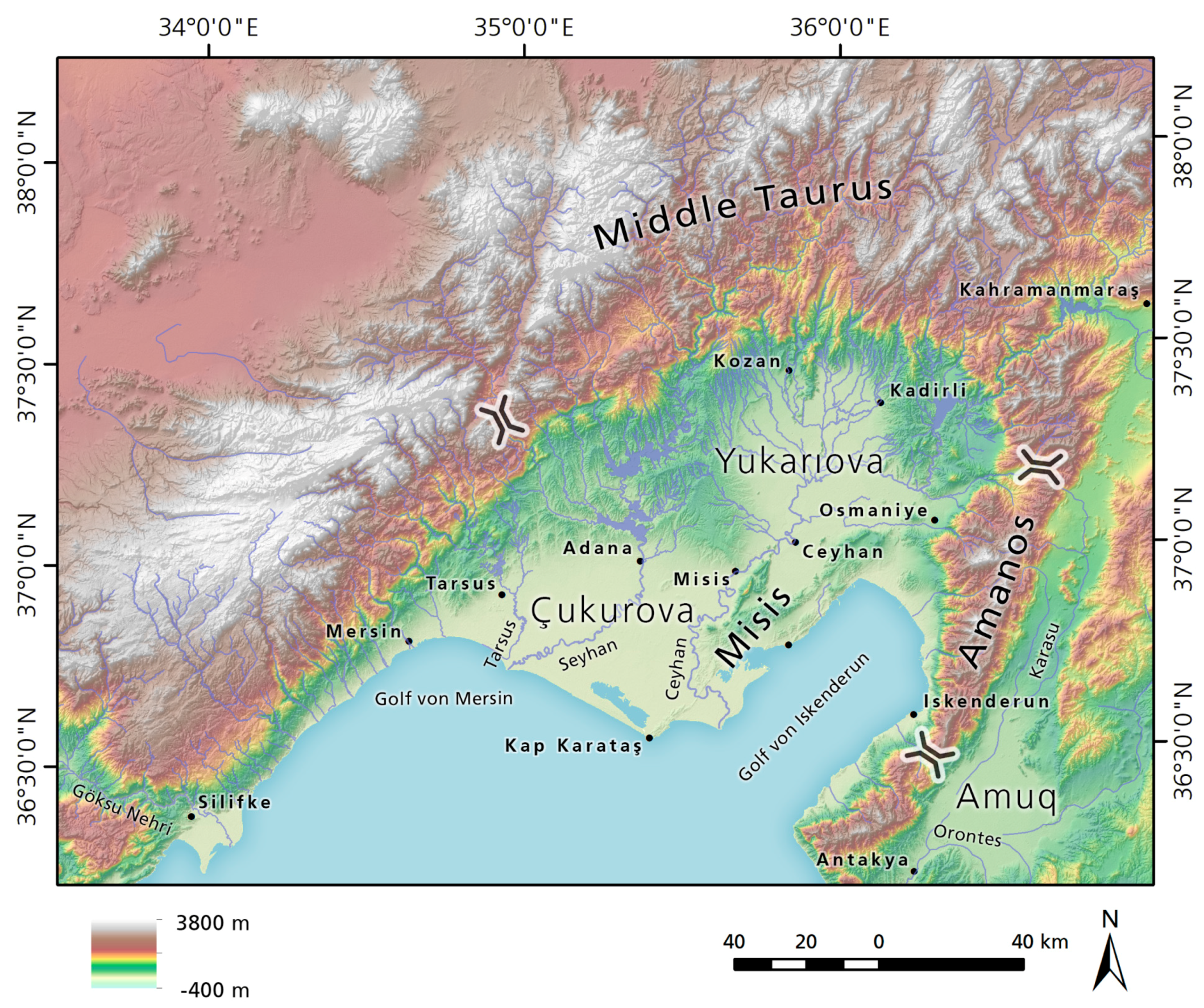
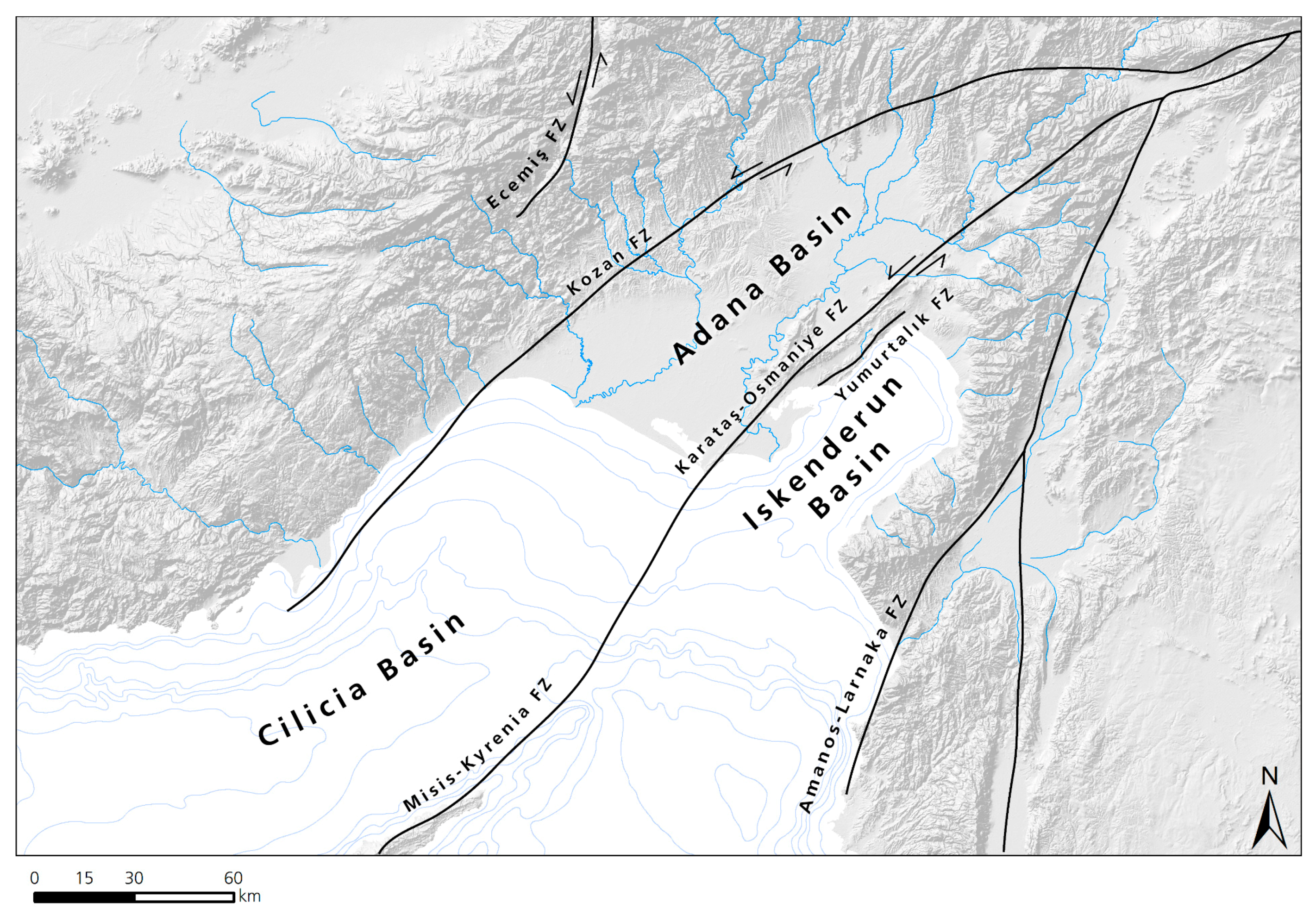
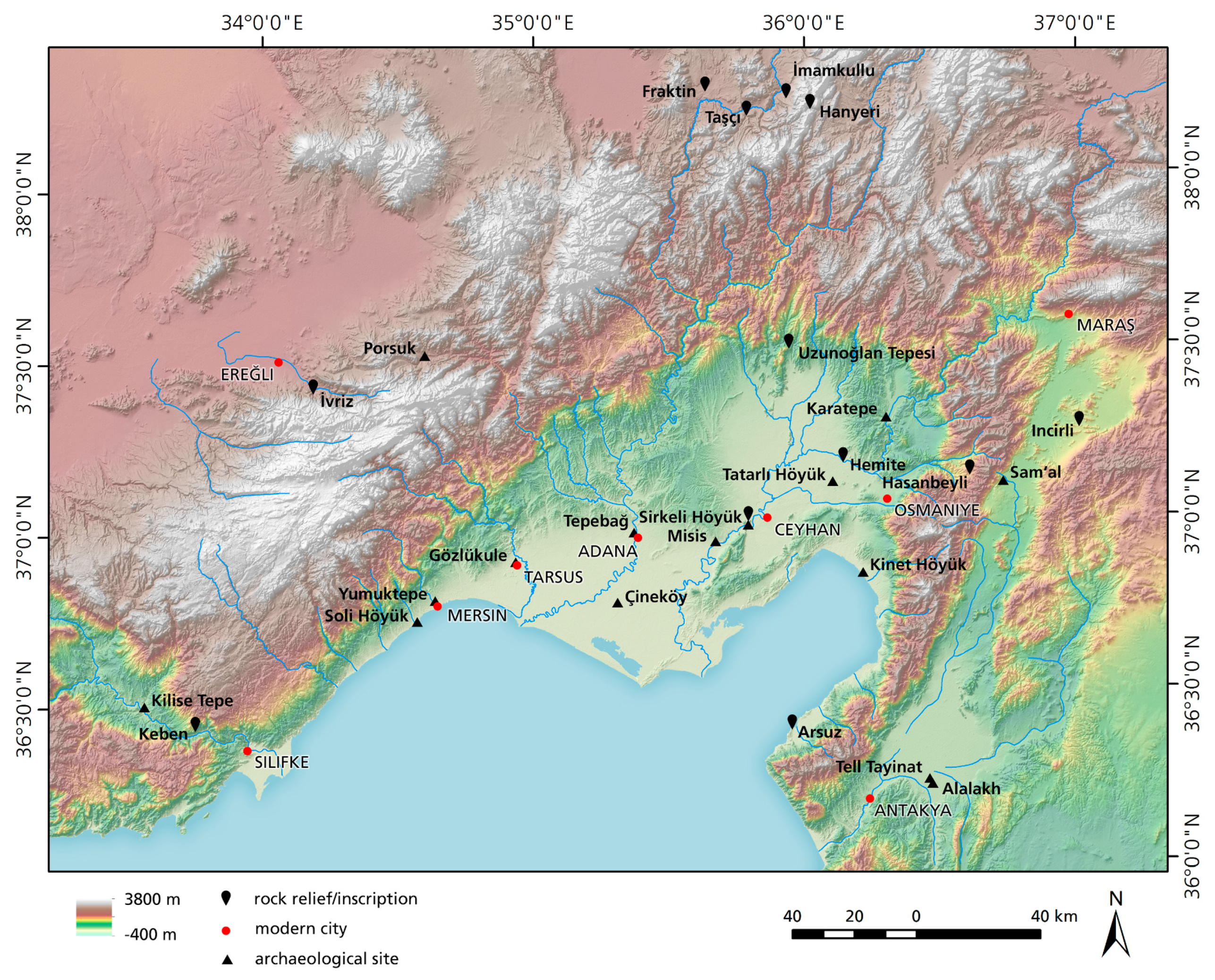
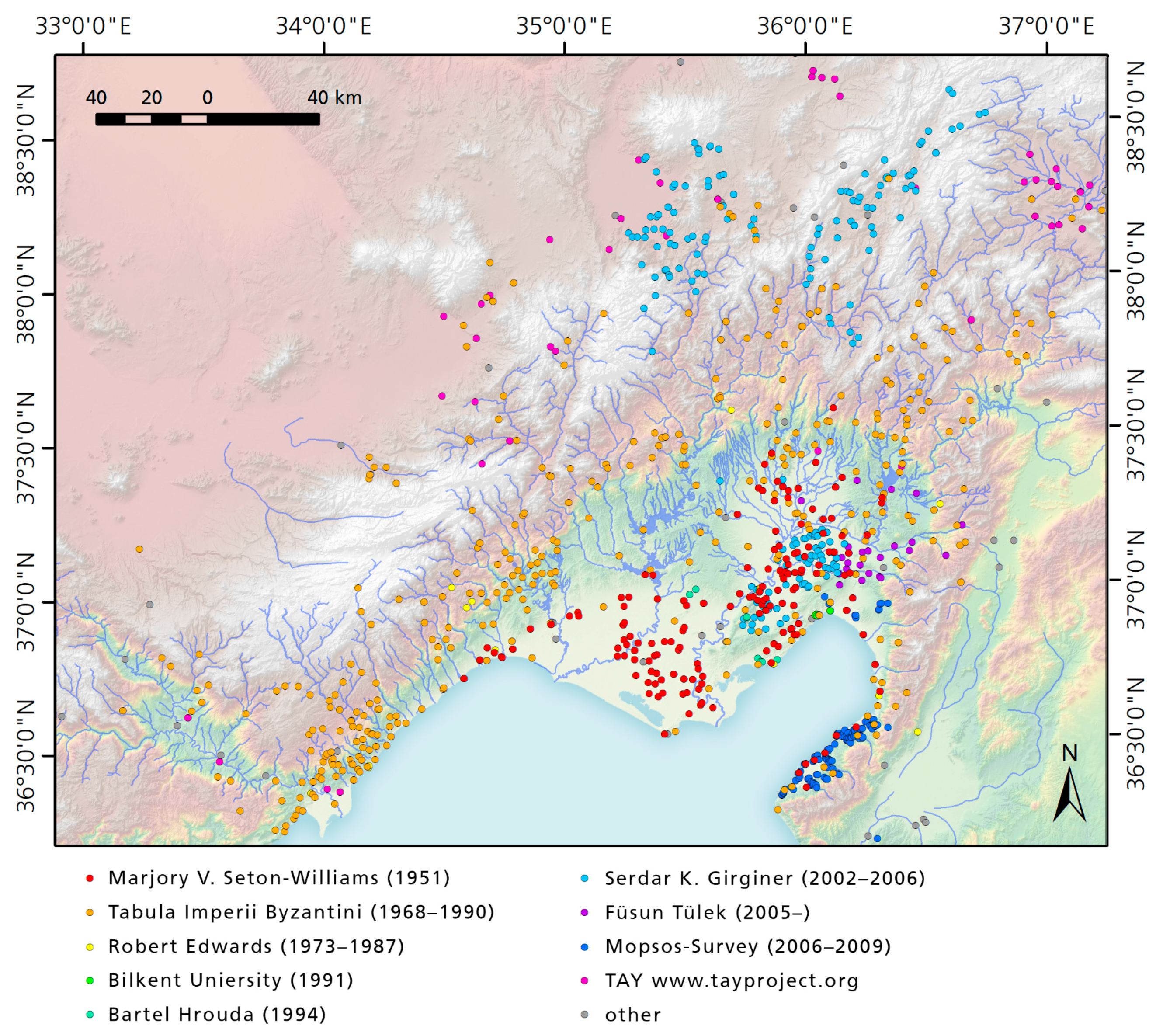

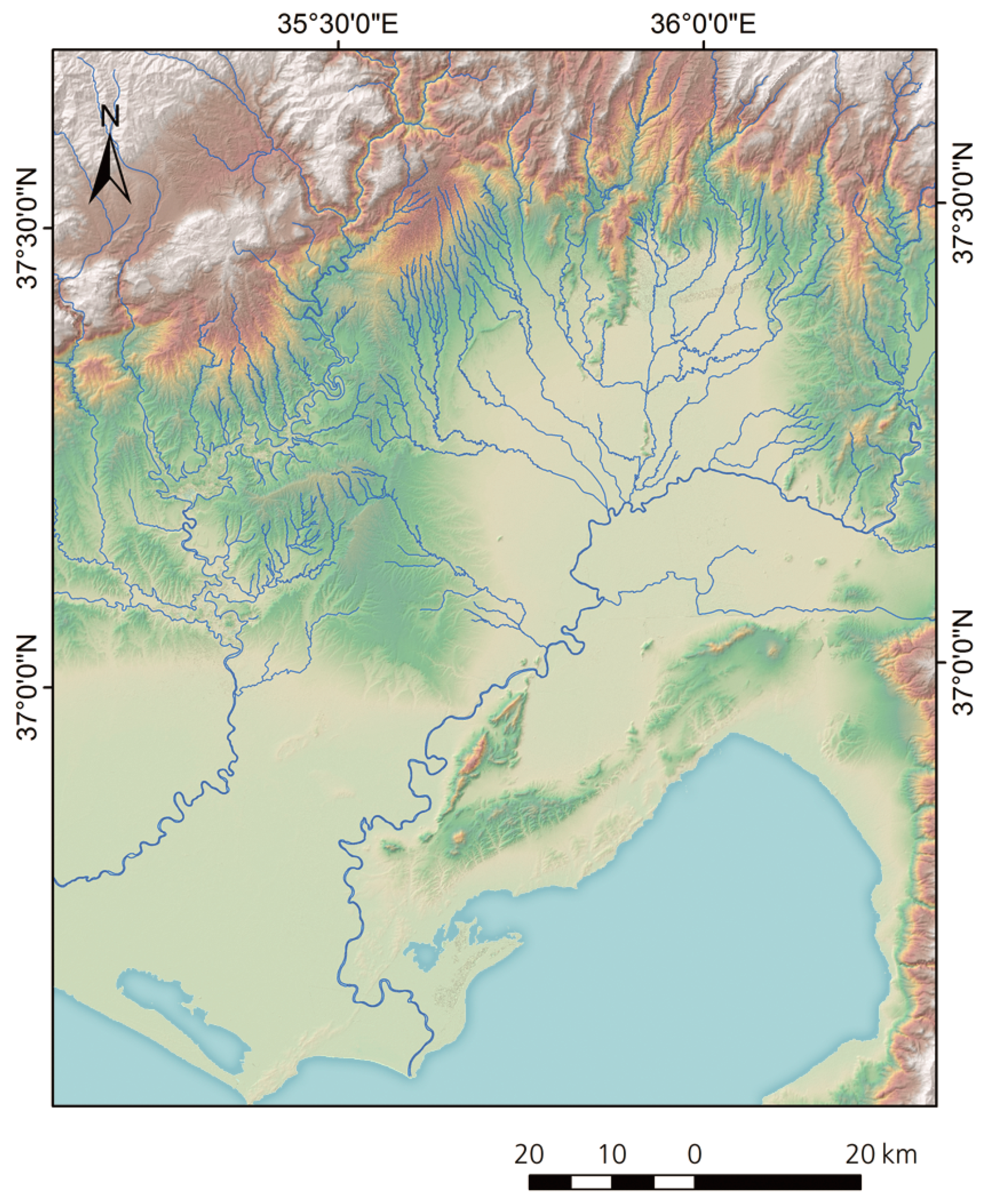
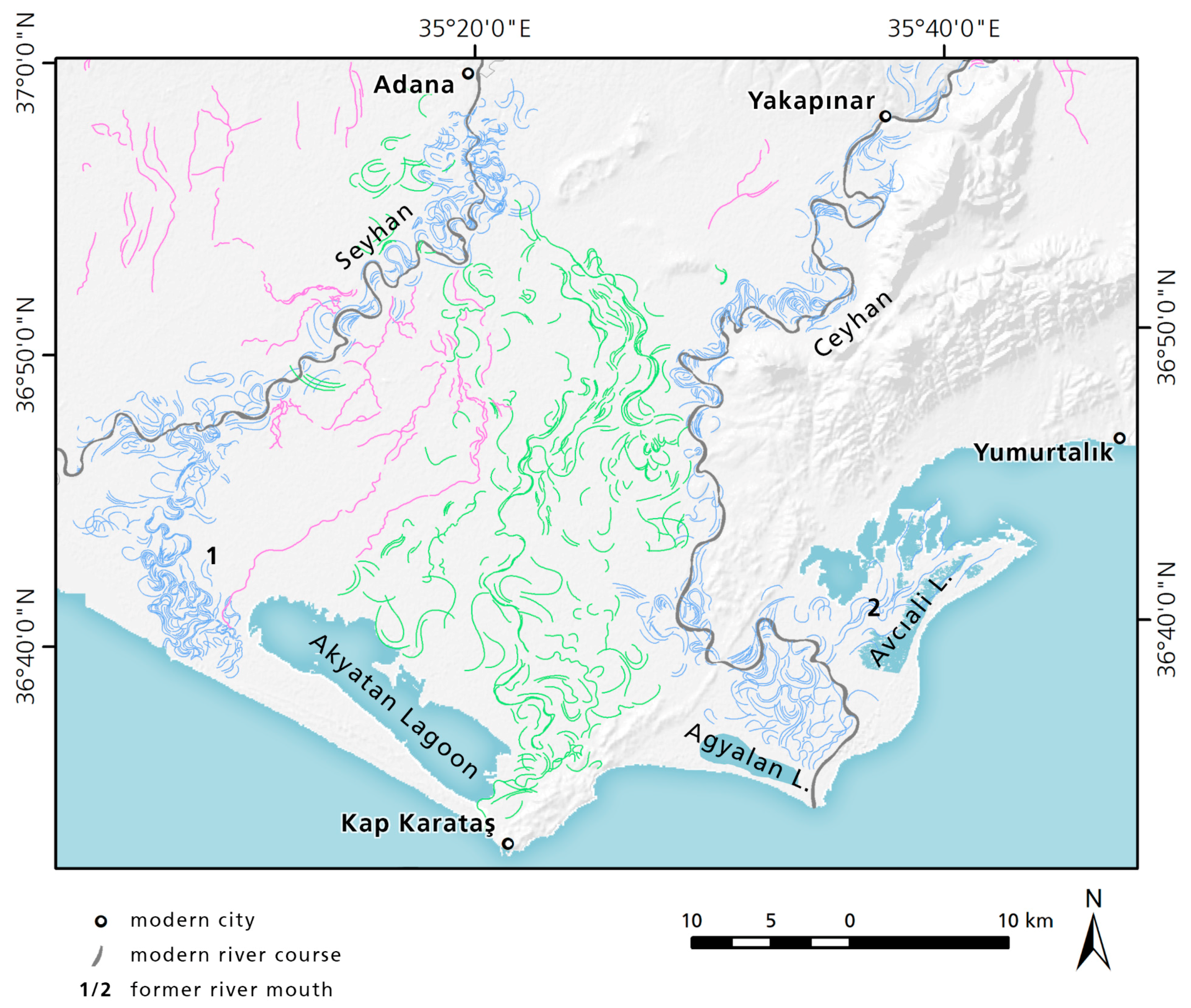

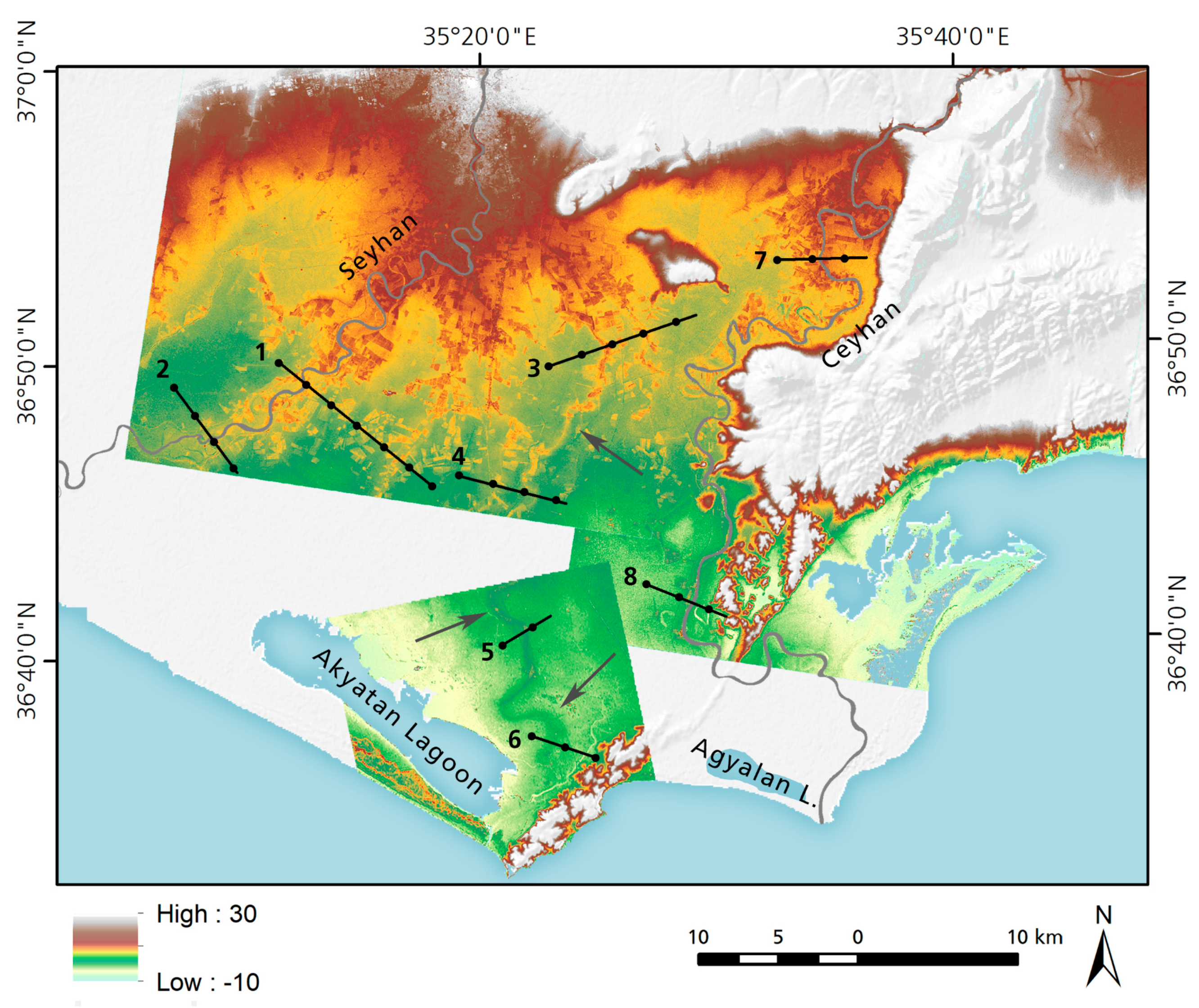
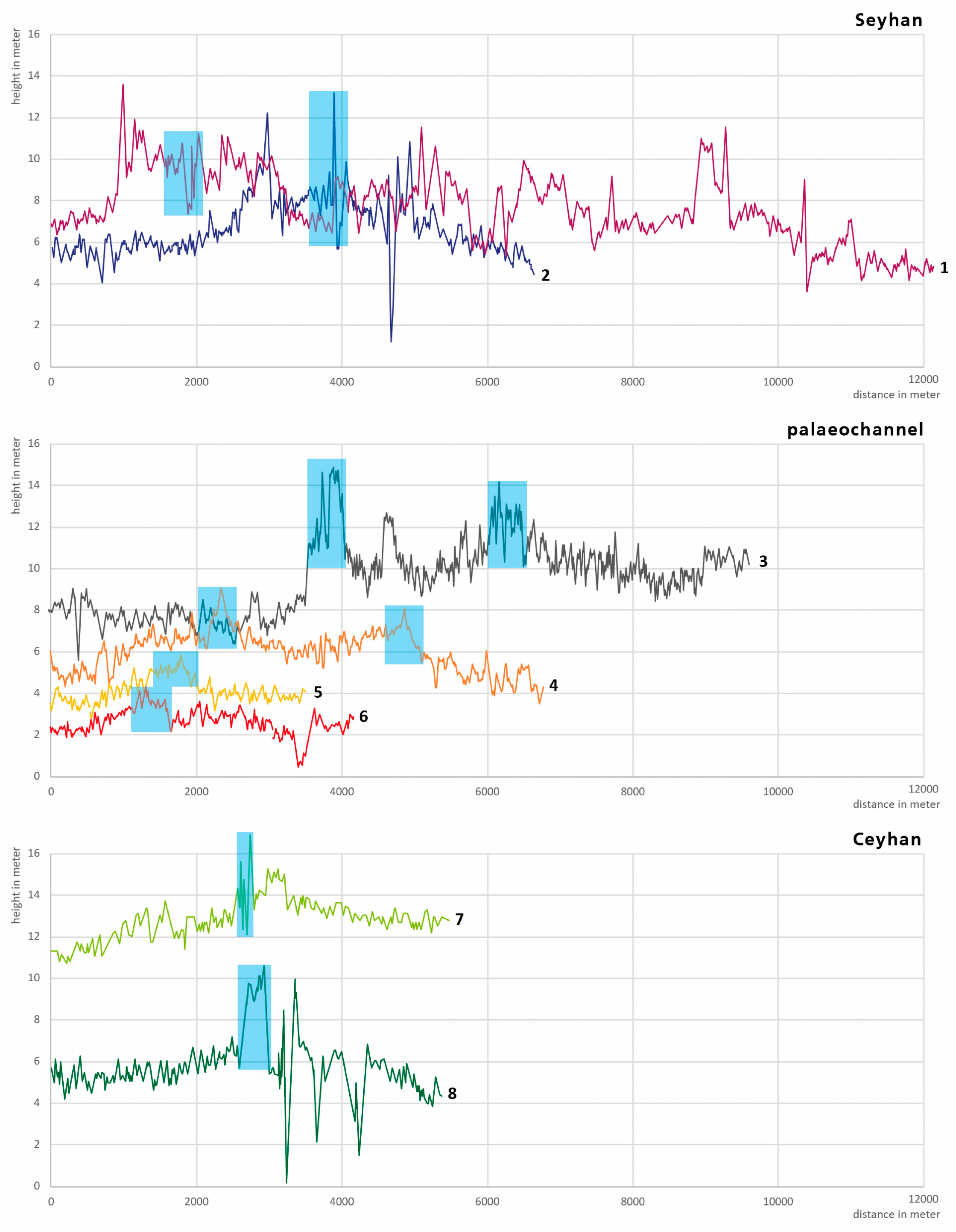
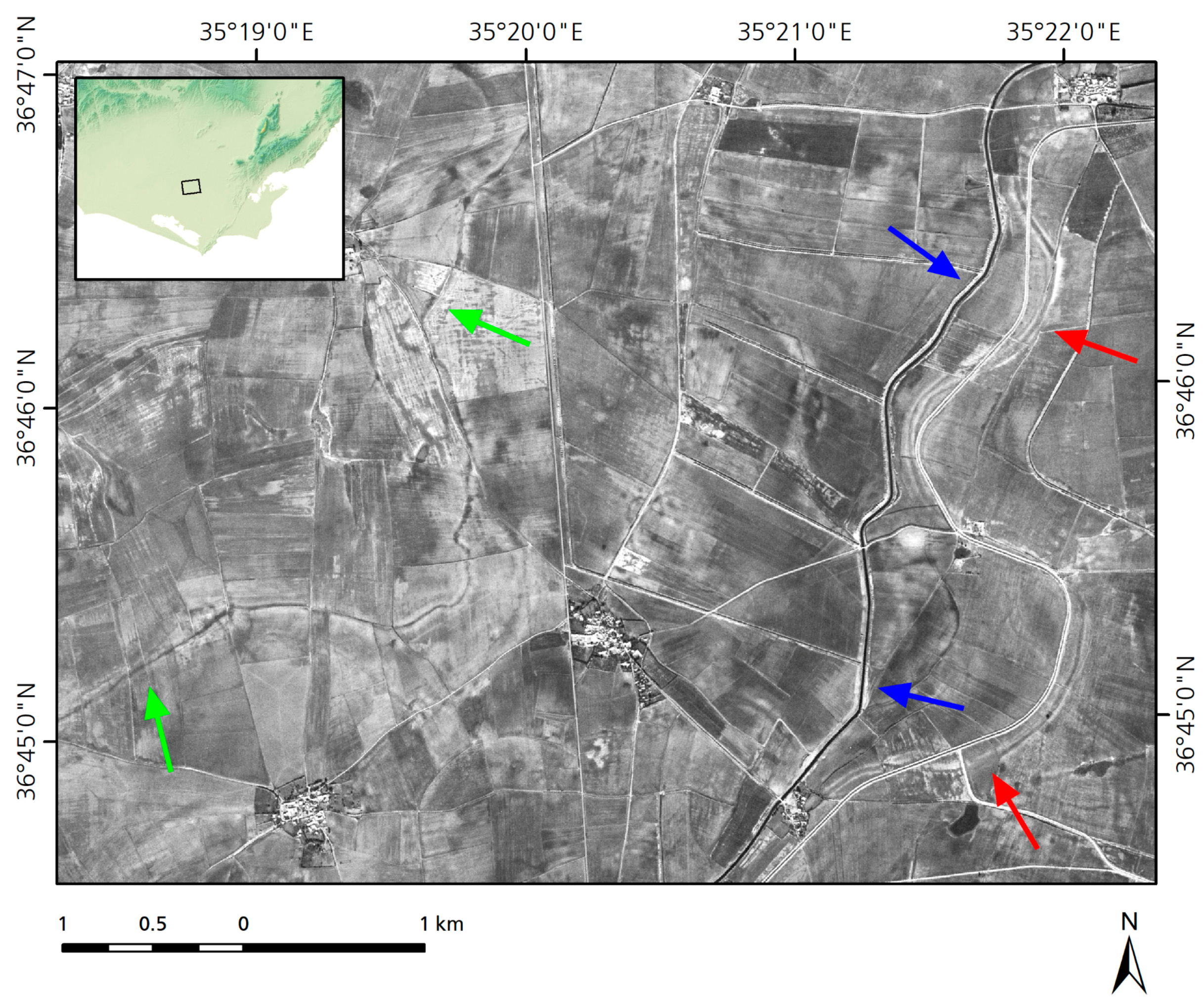
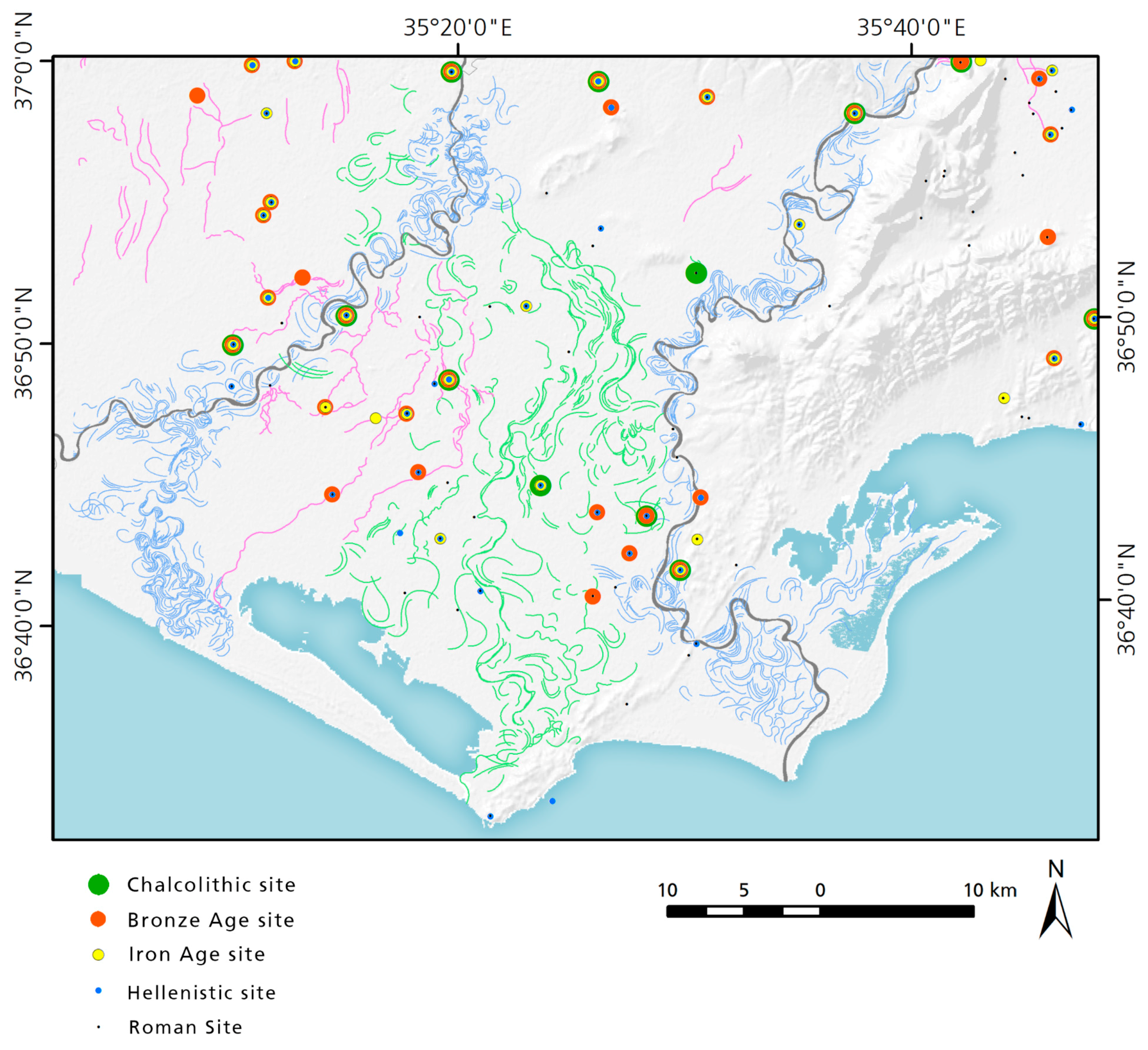
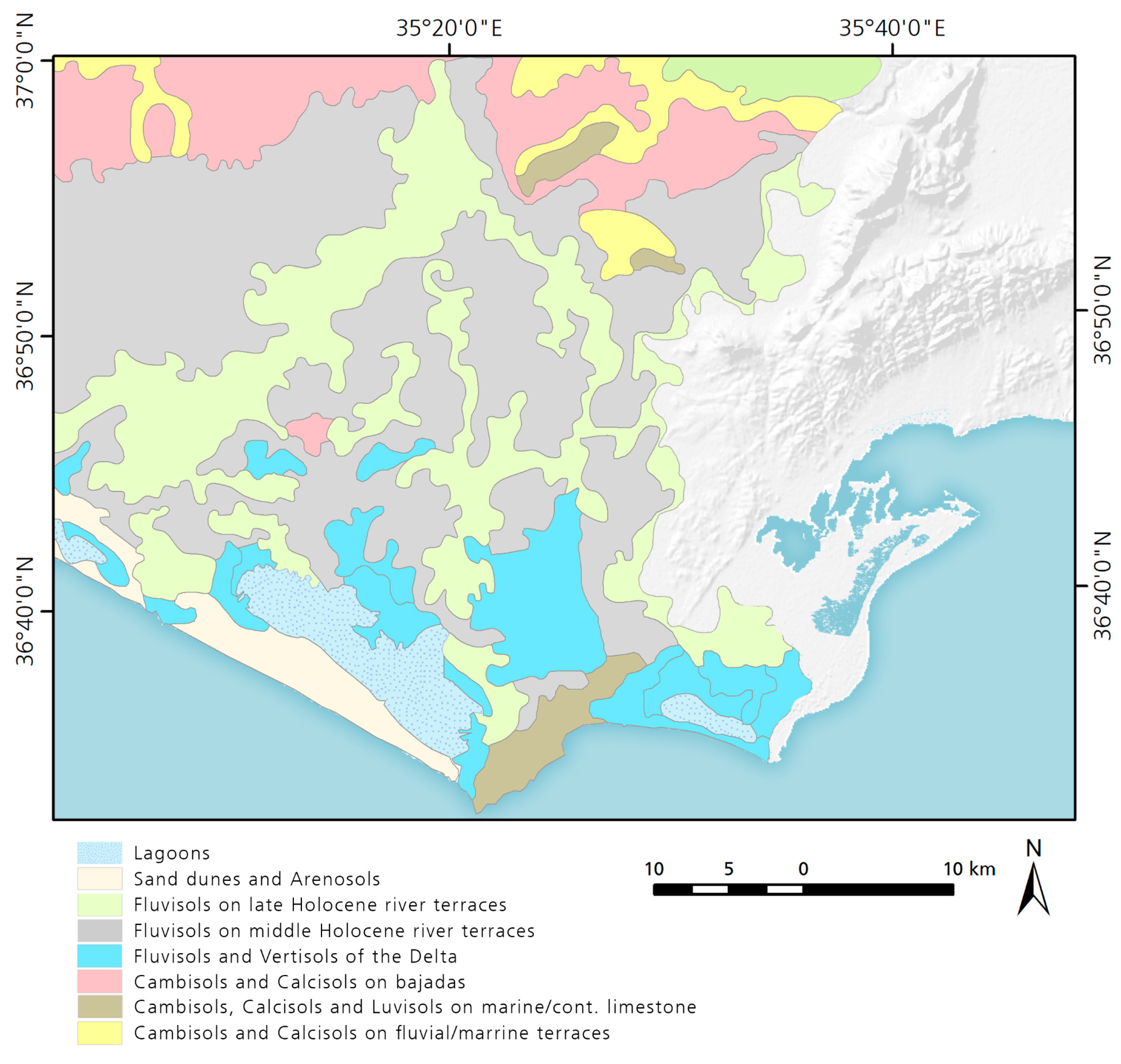

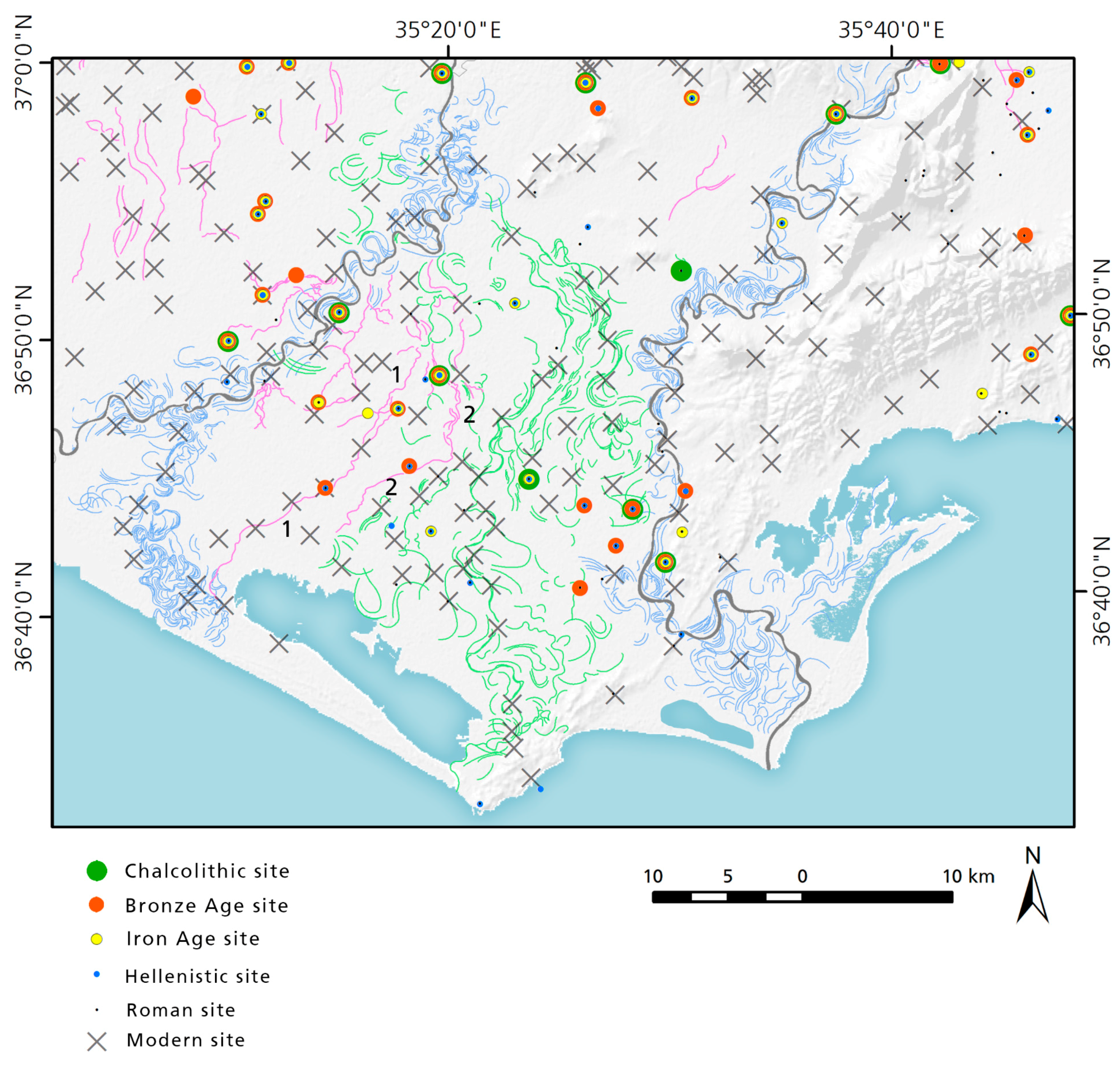
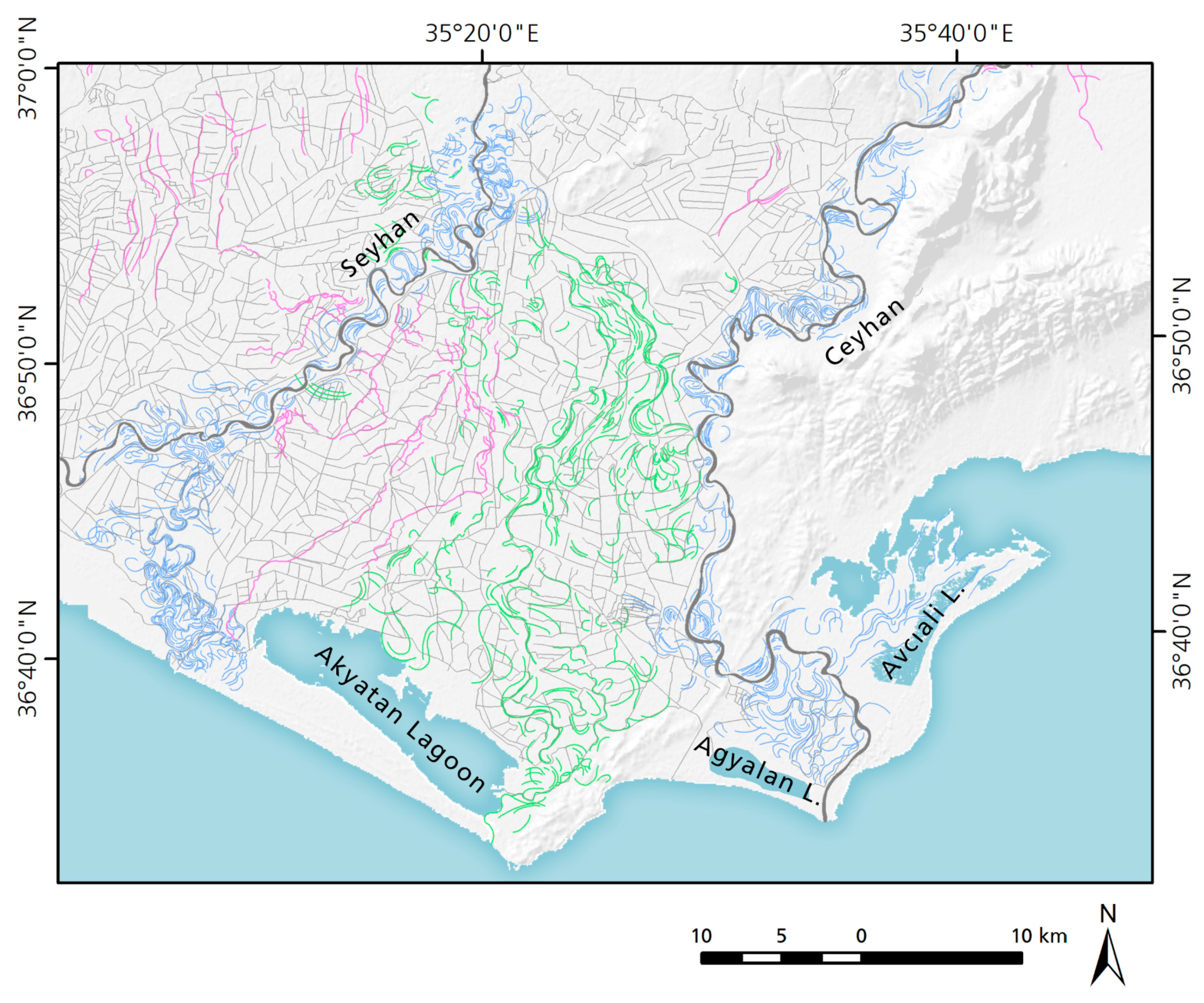
© 2017 by the authors. Licensee MDPI, Basel, Switzerland. This article is an open access article distributed under the terms and conditions of the Creative Commons Attribution (CC BY) license (http://creativecommons.org/licenses/by/4.0/).
Share and Cite
Rutishauser, S.; Erasmi, S.; Rosenbauer, R.; Buchbach, R. SARchaeology—Detecting Palaeochannels Based on High Resolution Radar Data and Their Impact of Changes in the Settlement Pattern in Cilicia (Turkey). Geosciences 2017, 7, 109. https://doi.org/10.3390/geosciences7040109
Rutishauser S, Erasmi S, Rosenbauer R, Buchbach R. SARchaeology—Detecting Palaeochannels Based on High Resolution Radar Data and Their Impact of Changes in the Settlement Pattern in Cilicia (Turkey). Geosciences. 2017; 7(4):109. https://doi.org/10.3390/geosciences7040109
Chicago/Turabian StyleRutishauser, Susanne, Stefan Erasmi, Ralph Rosenbauer, and Ralf Buchbach. 2017. "SARchaeology—Detecting Palaeochannels Based on High Resolution Radar Data and Their Impact of Changes in the Settlement Pattern in Cilicia (Turkey)" Geosciences 7, no. 4: 109. https://doi.org/10.3390/geosciences7040109




